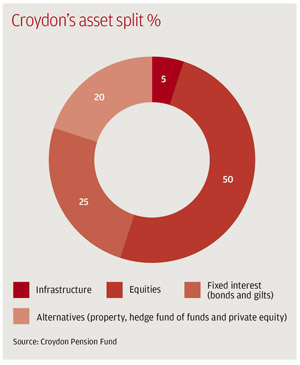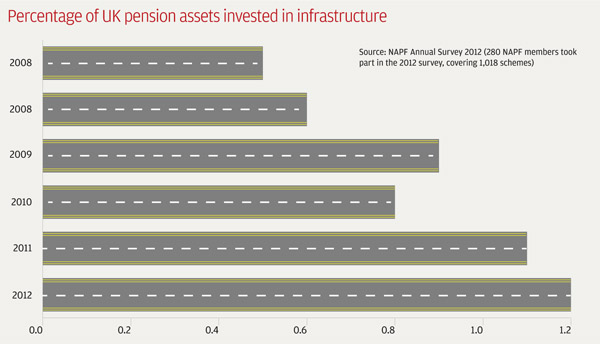Elusive returns over the past few years have led many pension schemes to look to alternative investments. Croydon Pension Fund is hoping infrastructure will provide the right results over the long term
Ask any pension fund why infrastructure is an ideal investment option and they are likely to cite the long-term, index-linked characteristics of the asset class.
For the full The Specialist report on property and infrastructure, go here to find the PDF.
These features played a big part in Croydon Pension Fund’s recent decision to add infrastructure to its investment portfolio. Its plan to allocate 5 per cent of its £650m fund to the asset has just been approved by the authority’s pensions committee, and it is now preparing to scan the market for opportunities.
Like many of its peers, the scheme was in search of an alternative to bonds, which have been producing poor returns in recent years.

With an urgent need for some form of index-linked income, infrastructure seemed the obvious option.
“We look at the duration stuff, and these are typically funds with long, 10, 15, 20-year durations, which matches our profile,” says Nigel Cook, head of pensions and treasury at the scheme.
“The fact they have that underwriting guarantee is also attractive. We see it as an alternative to what would have been a gilt investment, maybe five or 10 years ago.”
Despite its new strategy, Croydon’s move is not its first contact with infrastructure.
It has had a small amount of exposure over the past couple of years through its investment in two funds run by Equitix, which focus on private finance initiatives and public private partnerships.
The scheme now believes this experience provides a good foundation for it to build upon.
Growing appetite
Investing in infrastructure is increasingly becoming a real consideration for funds, with local government schemes now taking a particular interest.
Martin Lennon, head of Infracapital, the infrastructure investor within asset manager M&G Investments, says: “It is true that public sector pension schemes tend to view the asset class with particular favour. Certainly the apparent support for the Pensions Infrastructure Platform demonstrates this.
“But infrastructure also appeals to any pension fund or institutional investor prepared to set aside capital to meet longer-term investment targets such as yield or inflation, or to match their liabilities.”
But despite this growing interest in initiatives like Pip – led by the National Association of Pension Funds and the Pension Protection Fund – UK funds’ investment in infrastructure remains relatively low overall.
Public and private funds have just 1.2 per cent of assets invested in infrastructure, according to figures from the NAPF’s 2012 annual survey. But figures from its 2007 survey show this level of investment was just 0.5 per cent, suggesting a growth in appetite, albeit a slow one.

Part of the reason for the sluggish progress towards such projects could be the cost barriers to investing directly. Cook says the Croydon fund could never have joined the Pip initiative, for example, because it does not have the scale required.
“We’re a fund of £650m; Pip has a [lower limit] of £100m commitments. So we were never going to be a partner in that process, because we simply wouldn’t commit that much money to anything.”
Challenges
Encouraging pension schemes to invest in infrastructure is something government officials have talked about extensively. They see it as a way to address the funding shortfall for projects, and last year the government committed to guarantee £40bn of investment in greenfield ventures from risks such as construction delays or overspends.
Government officials have also said they want to attract £20bn of capital to infrastructure projects from a range of institutional investors, including pension funds.
For the full The Specialist report on property and infrastructure, go here to find the PDF.
But there are challenges to be overcome. Joanne Segars, chief executive of the NAPF, recently discussed the limited availability of brownfield assets, and said it might need to rethink its stance on avoiding construction risk as a result.
A lack of opportunities is something Croydon has been considering as it prepares to scan the market. Like most funds, it is adamant it wants to avoid construction risk, so it is seeking brownfield opportunities.
To fulfil this aim it intends to look beyond the UK, so it can choose from a wider range of potential investment options.
“It would be a mistake just to focus in on the UK because you’re not going to get the diversity of different schemes there,” says Cook. “[If you just stay here] you are going to have a concentration of risk and [so] we would avoid a regional concentration of risk.”
Croydon is also not interested in listed infrastructure, as it already has that as part of its equity portfolio. Instead it will be looking at unlisted infrastructure funds, which are typically offered as limited partnerships or shares of offshore funds.
When looking at investment opportunities it is important for schemes to have a full understanding of the risks, says Hugh Gittins, principal associate at law firm Eversheds.
“Some of the challenges to accessing infrastructure in the past have been due to a lack of resource and a lack of understanding on the part of pension funds,” he says.
“Even the larger ones don’t necessarily have the quite specialist amount of expertise that is required when you are considering investments of this kind.”
Investment approaches
Smaller funds that do not have the means to invest directly are – like Croydon – finding other ways to get involved in infrastructure, often by exploring buying into a fund and investing indirectly.
“Small and medium-sized enterprises are increasingly looking at the funds route, but there is quite a lot of due diligence that needs to be done to understand the fund,” says Paul Kitson, pensions partner at consultancy PwC.
“This includes what it’s doing, how it is investing and what sort of risk the pension fund is actually being exposed to.”
Croydon will report back to the council’s pensions committee in the autumn with its ideas for investment and hopes to have money invested by the end of the year.
While Cook is confident there are some “good infrastructure funds out there” with “good track records”, he says his team will be closely assessing the risks associated with any projects. Analysing whether they are likely to deliver the kind of returns promised will be a key part of the due diligence process, he adds.
So does Cook see infrastructure investment as the future? “Yes, but with reservations. Our stance has always got to be that we look at new things, we give them proper consideration, and if they fit our needs then we’ll go for it,” he says.






















